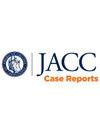KCNQ1 and GJA1 Variants Associated With Arrhythmogenic Right Ventricular Cardiomyopathy With a Lethal Outcome
Q4 Medicine
引用次数: 0
Abstract
Background
Arrhythmogenic right ventricular cardiomyopathy (ARVC) is mainly caused by desmosomal variants. Nondesmosomal ARVC is rare.
Case Summary
A 31-year-old athlete experienced sudden cardiac death. Autopsy revealed ARVC and syndactyly. Genetic testing identified a heterozygous pathogenic KCNQ1 variant associated with long QT syndrome, and a heterozygous likely pathogenic GJA1 variant encoding connexin-43, a gap junction protein. No relative had ARVC or prolonged QTc interval; however, GJA1-positive relatives had either syndactyly or a gait disorder; both of these pathologies are associated with GJA1.
Discussion
Connexin-43 is essential for desmosomal function; however, ARVC causation has not been established. Cascade genetic and clinical testing suggests that the combination of both variants and lifelong endurance exercise may have precipitated the ARVC phenotype.
Take-Home Messages
This is the first documented case linking GJA1 and KCNQ1 variants to ARVC. Comprehensive genetic and clinical family screening is vital for assessing the individual contribution of each variant to the diagnosis and arrhythmic risk.
KCNQ1和GJA1变异与致心律失常性右室心肌病的致命结果相关
背景:心律失常性右室心肌病(ARVC)主要由桥粒体变异引起。非桥胞体ARVC很少见。一例31岁运动员心源性猝死。尸检显示ARVC和并指。基因检测鉴定出一种与长QT综合征相关的杂合致病性KCNQ1变异,以及一种编码连接蛋白43(一种间隙连接蛋白)的杂合可能致病性GJA1变异。亲属无ARVC或QTc间期延长;然而,gja1阳性的亲属有并指或步态障碍;这两种病理都与GJA1有关。connexin -43对桥粒体功能至关重要;然而,ARVC的病因尚未确定。级联遗传和临床测试表明,这两种变异和终身耐力运动的结合可能促成了ARVC表型。这是第一个将GJA1和KCNQ1变体与ARVC联系起来的文献病例。全面的遗传和临床家庭筛查对于评估每个变异对诊断和心律失常风险的个体贡献至关重要。
本文章由计算机程序翻译,如有差异,请以英文原文为准。
求助全文
约1分钟内获得全文
求助全文
来源期刊

JACC. Case reports
Medicine-Cardiology and Cardiovascular Medicine
CiteScore
1.30
自引率
0.00%
发文量
404
审稿时长
17 weeks
 求助内容:
求助内容: 应助结果提醒方式:
应助结果提醒方式:


